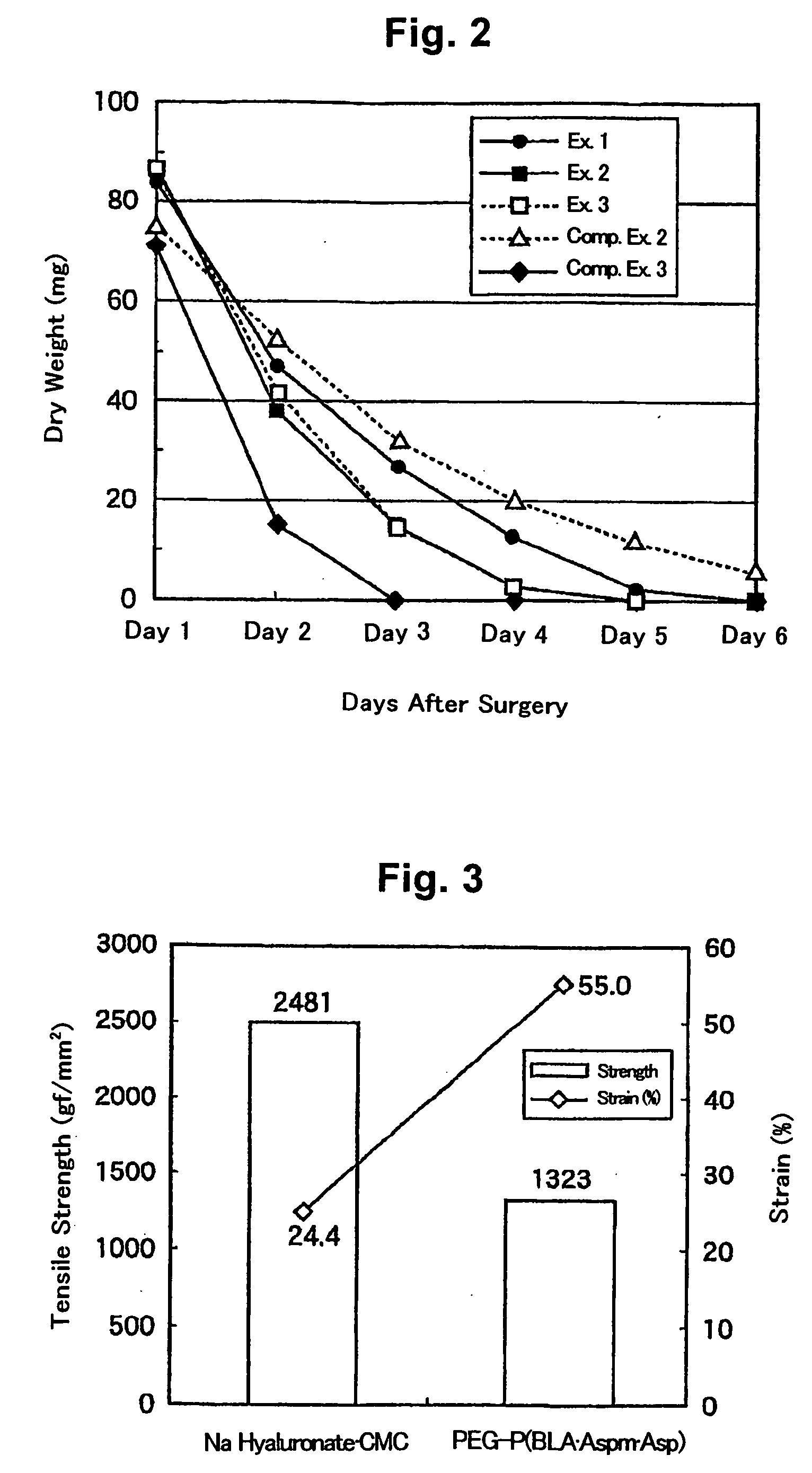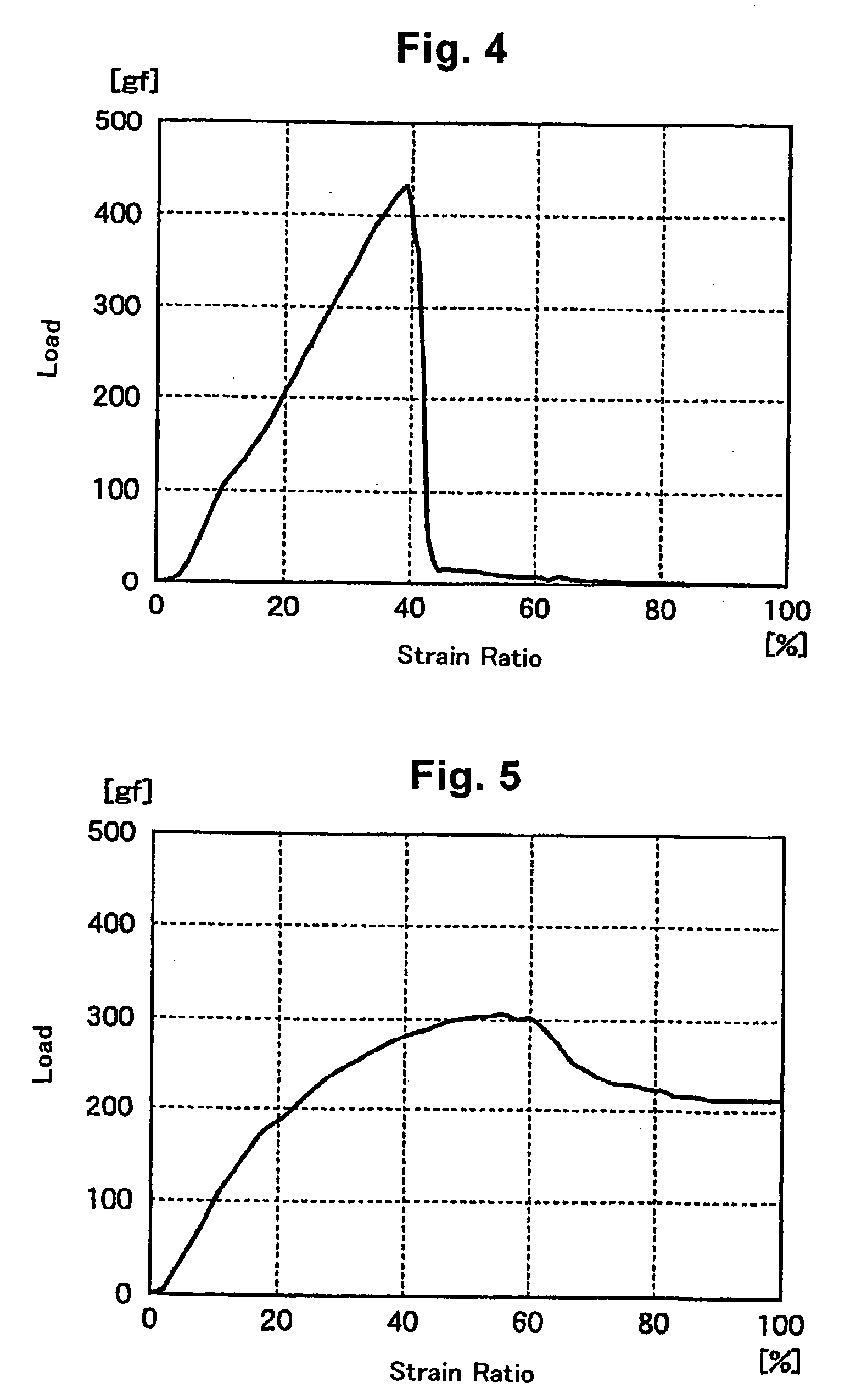Polymer, bioabsorbable material and film for preventing tissue fusion
a bioabsorbable material and film technology, applied in the field of polymer, can solve the problems of insufficient bioabsorption rate, slow biodegradation rate, and insufficient balance of required functionalities of conventional biomaterials, and achieve the effect of preventing tissue fusion, preventing tissue fusion, and avoiding fusion
- Summary
- Abstract
- Description
- Claims
- Application Information
AI Technical Summary
Benefits of technology
Problems solved by technology
Method used
Image
Examples
example 1
Synthesis of Polymer
[0060] 1.0 g of PEG having amino groups at both ends (20000 g / mol) was dissolved in 7 ml of DMF in a 40° C. oil bath in a dry inert gas atmosphere, and 800 mg (64 equivalents of PEG) of β-benzyl-L-aspartate-N-carboxylic anhydride (abbreviated as BLA-NCA hereinbelow) was added. After overnight reaction, the reactant was added dropwise into an ice-cooled diisopropyl ether to precipitate white solid. The solid was separated by suction filtration, dissolved in methylene chloride, crystallized repeatedly, and dried under reduced pressure, to thereby obtain a PBLA-PEG-PBLA block copolymer.
[0061] 1.0 g of the obtained block copolymer was re-dissolved in 10 ml of chloroform, and 0.78 ml of a 0.43N sodium hydroxide solution was added. After reacting for 10 minutes at room temperature, the reactant was added dropwise into diisopropyl ether to precipitate white solid. The solid was separated by suction filtration, and dried under reduced pressure to thereby obtain PEG-P(B...
example 2
[0071] PBLA-PEG-PBLA block polymer and PEG-P(BLA,Asp.Na,Asp) polymer of the A1-B-A2 type were prepared in the same way as in Example 1, except that the PEG was replaced with PEG having amino groups at both ends (11000 g / mol), and the amount of the sodium hydroxide solution was 1.86 ml.
[0072] Using the obtained polymers, various number average molecular weights and 1H-NMR were measured, the BLA content was calculated, and the bioabsorbable sheet was prepared and subjected to the tests in the same way as in Example 1. The results of the bioabsorbability test are shown in FIG. 2, and the number average molecular weights, the BLA content, and the results of the test on ability to prevent adhesion are shown in Table 1.
example 3
[0073] PBLA-PEG-PBLA block polymer and PEG-P(BLA,Asp.Na,Asp) polymer of the A1-B-A2 type were prepared in the same way as in Example 1, except that the amount of BLA-NCA was 100 equivalents of PEG, and the amount of the sodium hydroxide solution was 1.80 ml.
[0074] Using the obtained polymers, various number average molecular weights and 1H-NMR were measured, the BLA content was calculated, and the bioabsorbable sheet was prepared and subjected to the tests in the same way as in Example 1. The results of the bioabsorbability test are shown in FIG. 2, and the number average molecular weights, the BLA content, and the results of the test on ability to prevent adhesion are shown in Table 1.
PUM
| Property | Measurement | Unit |
|---|---|---|
| thickness | aaaaa | aaaaa |
| temperature | aaaaa | aaaaa |
| thickness | aaaaa | aaaaa |
Abstract
Description
Claims
Application Information
 Login to View More
Login to View More - R&D
- Intellectual Property
- Life Sciences
- Materials
- Tech Scout
- Unparalleled Data Quality
- Higher Quality Content
- 60% Fewer Hallucinations
Browse by: Latest US Patents, China's latest patents, Technical Efficacy Thesaurus, Application Domain, Technology Topic, Popular Technical Reports.
© 2025 PatSnap. All rights reserved.Legal|Privacy policy|Modern Slavery Act Transparency Statement|Sitemap|About US| Contact US: help@patsnap.com



